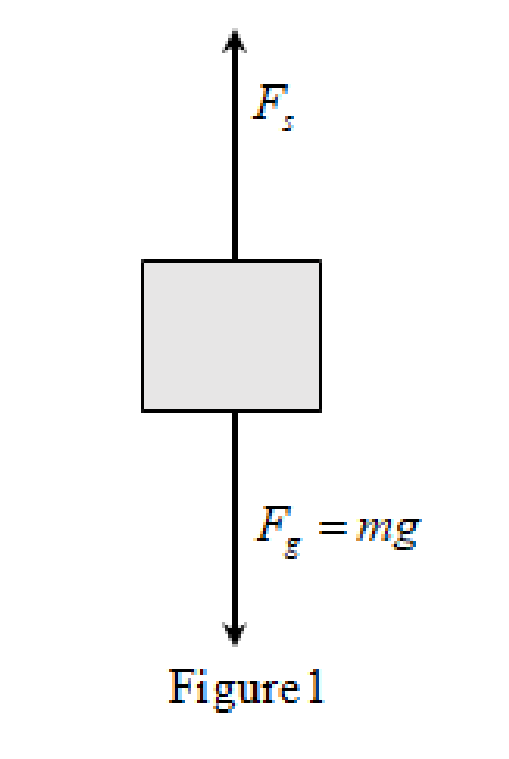
Concept explainers
(a)
The length of the cord.
(a)
Answer to Problem 85CP
The length of the cord is
Explanation of Solution
Consider the body-cord-baloon as a isolated system under gravitation force.
Since the potential energy of the daredavil is transformed to spring energy of the cord.
Write the equation for conservation of energy
Here,
Since there is no initial and final motion and hence the change in kintetic energy is zero.
Subsitute
Write the expression for total potential energy
Here,
Write the expression for potential energy of the cord of length
Write the expression for potential energy due to gravity
Here,
Write the expression for change in total potential energy
Here,
Substitute
Here,
Simplify the above equation.
Since the daredavil finds out the length of stretched cord when hanging at rest by it.

Write the expression for equation for force from Figure 1.
Here,
Write the expression for body weight
Here,
Write the expression for spring force
Here,
Substitute
Since the cord is uniform and elastic.
Hence, spring constant of cord is proportional to the length of the cord.
Rearange the above equation.
When the daredavil test the cord he finds out that his body weight stretches it.
The rate of stretch of the spring or cord is depends on the length and stiffness of the spring or cord. The rate of stretches is the ratio of change in length or stretches to the orginal length of the spring or cord. If the the length of the spring or cord is
Substitute
Simplify the above equation.
Substitute
Since the length of stretched cord should be the equal to the length of the jump.
Write the equation for streched length of the cord which has
Sustitute
Conclusion:
Substitute
Simplify the above expression in terms of
Substitute
Solve the above quadratic equation.
Since the length of the cord cannot be more than
Thus, the length of the cord is
(b)
The maximum acceleration which daredevil will experience.
(b)
Answer to Problem 85CP
The maximum acceleration which daredevil will experience is
Explanation of Solution
Write the equation for motion of daredevil
Here,
Substitute
Solve the above equation to find the expression for
Substitute
Simplify the above equation.
Write the expression for stretched cord length
Rearrange the above equation.
Here,
When the daredevil uses the cord of
Conclusion:
Substitute
Substitute
Thus, the maximum acceleration which daredevil will experience is
Want to see more full solutions like this?
Chapter 8 Solutions
Physics for Scientists and Engineers with Modern Physics, Technology Update
- An inclined plane of angle = 20.0 has a spring of force constant k = 500 N/m fastened securely at the bottom so that the spring is parallel to the surface as shown in Figure P6.61. A block of mass m = 2.50 kg is placed on the plane at a distance d = 0.300 m from the spring. From this position, the block is projected downward toward the spring with speed v = 0.750 m/s. By what distance is the spring compressed when the block momentarily comes to rest?arrow_forwardA sky diver plans to bungee jump from a tower 74.0 m above the ground. She plans to use a uniform elastic cord, tied to a harness around her body, to stop her fall at a point 11.0 m above the water. Model her body as a particle and the cord as having negligible mass and obeying Hooke's law. In a preliminary test she finds that when hanging at rest from a 5.00 m length of the cord, her body weight stretches it by 1.25 m. She will drop from rest at the point where the top end of a longer section of the cord is attached to the tower. (a) What length of cord should she use? m (b) What maximum acceleration will she experience? m/s²arrow_forwardCan you help me with this problem?A block with a mass m is initially compressing a spring by x1 on a horizontal floor with friction. The spring has a spring constant k. The block is realeased from rest and travels a total distance of D including x1 and has a speed of v. what is the coefficent of kinetic friction between the floor and block?arrow_forward
- A 7.00 ✕ 105 kg subway train is brought to a stop from a speed of 0.500 m/s in 0.900 m by a large spring bumper at the end of its track. What is the force constant k of the spring (in N/m)?arrow_forwardA student with mass m=60kg is bungee jumping. What would be a proper length of a rope if the student plans to jump from a bridge (h=70 m)? It is known that under a static test with a 100 kg test mass that this brand of rope expands by 10m.arrow_forwardA horizontal spring with spring constant 290 N/m is compressed by 15 cm and then used to launch a 300 g box across the floor. The coefficient of kinetic friction between the box and the floor is 0.23. What is the box's launch speed? Express your answer with the appropriate units.arrow_forward
- When a 3.5 kg block is pushed against a massless spring of force constant 4.5 x 103 N/m, the spring is compressed 7.9 cm. The block is released, and it slides 2.8 m (from the point at which it is released) across a horizontal surface before friction stops it. What is the coefficient of kinetic friction between the block and the surface?arrow_forwardWhen a 3.0-kg block is pushed against a massless spring of force constant constant 4.5 × 103 N/m, the spring is compressed 8.0 cm. The block is released, and it slides 2.0 m (from the point at which it is released) across a horizontal surface before friction stops it. What is the coefficient of kinetic friction between the block and the surface?arrow_forwardA gymnast of mass 52.0 kg is jumping on a trampoline. She jumps so that her feet reach a maximum height of 3.12 m above the trampoline and, when she lands, her feet stretch the trampoline 70.0 cm down. How far does the trampoline stretch whe she stands on it at rest? Assume that the trampoline is described by Hooke's law when it is strecthed.arrow_forward
- A block falls from a table 6 m high. It lands on an ideal, massless, vertical spring with a force constant of 2.4 kN/m. The spring is initially 25 cm high, but it is compressed to a minimum height of 10 cm before the block is stopped. Find the mass of the block.arrow_forwardan air-track glider of mass 0.100 kg is attached to the end of a horizontal air track by a spring with force constant 20.0 N/m. Initially the spring is unstretched and the glider is moving at 1.50 m/s to the right. Find the maximum distance d that the glider moves to the right if the air is turned off, so that there is kinetic friction with coefficient muk=0.47arrow_forwardThe 1.1 kgkg physics book in figure is connected by a string to a 550 gg coffee cup. The book is given a push up the slope and released with a speed of 2.9 m/sm/s . The coefficients of friction are μsμs =0.50=0.50 and μkμk =0.20=0.20. How far does the book slide? Express your answer with the appropriate units.arrow_forward
 Principles of Physics: A Calculus-Based TextPhysicsISBN:9781133104261Author:Raymond A. Serway, John W. JewettPublisher:Cengage Learning
Principles of Physics: A Calculus-Based TextPhysicsISBN:9781133104261Author:Raymond A. Serway, John W. JewettPublisher:Cengage Learning Classical Dynamics of Particles and SystemsPhysicsISBN:9780534408961Author:Stephen T. Thornton, Jerry B. MarionPublisher:Cengage Learning
Classical Dynamics of Particles and SystemsPhysicsISBN:9780534408961Author:Stephen T. Thornton, Jerry B. MarionPublisher:Cengage Learning

